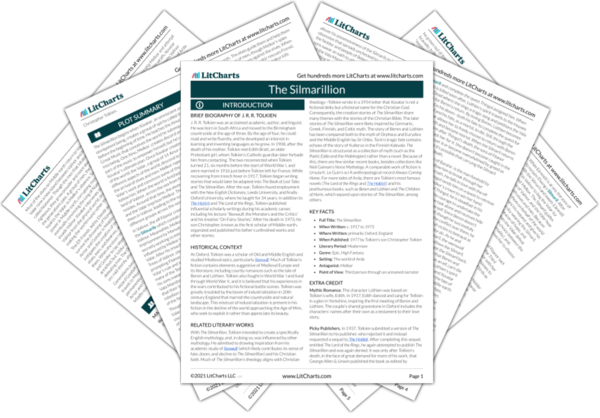Unity vs. Division
In The Silmarillion, J.R.R Tolkien’s collection of elven myths, the Valar (the spirits who create and rule the world), elves, and men are each brought into being as a like-minded, united group that becomes divided over time. The elves naturally break into smaller groups based on where they want to live and what leader they want to follow. Similarly, the men slowly separate as they leave the place of their awakening to wander Middle-earth…
read analysis of Unity vs. DivisionFate, Doom, and Free Will
The Silmarillion begins with the first conceptualization of the world, Arda, by the omniscient being Ilúvatar, and explores the boundaries of free will in a world controlled by fate. There are three kinds of fate at work in Arda—one is individually driven by choices and actions, one is the result of curses and inheritance, and one is the plan of Ilúvatar that drives the world towards a preordained “doom” (a word Tolkien uses…
read analysis of Fate, Doom, and Free WillPride and Arrogance
In The Silmarillion, the world of Arda is plagued by the evil that comes from excessive pride. Before the world is created, Melkor is driven by his pride—his “vain” desire for power and glory—to alter his portion of the Great Music taught to him by his creator Ilúvatar, disrupting the music and marring the world born from it. Fëanor and his sons, in their arrogance, swear an oath that’s impossible to fulfill, leading…
read analysis of Pride and Arrogance
Greed, Jealousy, and Obsession
Greed and jealousy plague the world of Arda in The Silmarillion. The primary objects of greed and obsession in the First Age are the titular Silmarils, three jewels created by the elf Fëanor. Melkor, himself jealous of the other Valar, spreads greed and jealousy among the elves and men to sow discord, like when he suggests to Fëanor that the Valar want his Silmarils. Later, Fëanor becomes obsessively protective of…
read analysis of Greed, Jealousy, and ObsessionInevitable Loss
The Silmarillion tells the story of the world, Arda, from its conception to the end of the Third Age and the departure of the elves. Loss is woven into the world even before its creation. The Ainu Melkor creates discord in the music that plans the world, damaging it. Melkor continues filling the world with loss even as the Ainu work to shape it before the beginning of time, corrupting and destroying their creations…
read analysis of Inevitable LossMyth and Memory
In J.R.R. Tolkien’s The Silmarillion, a collection of stories spanning from the conception of the world to the Dominion of Men, the narrator frequently mentions how characters and events persist in history, myth, rumor, and memory. Though Tolkien doesn’t name or acknowledge his fictional narrator, the narrator has the perspective of an elf, along with the knowledge and reverence for the past an elf would have, adding depth and reality to the stories. The…
read analysis of Myth and Memory






